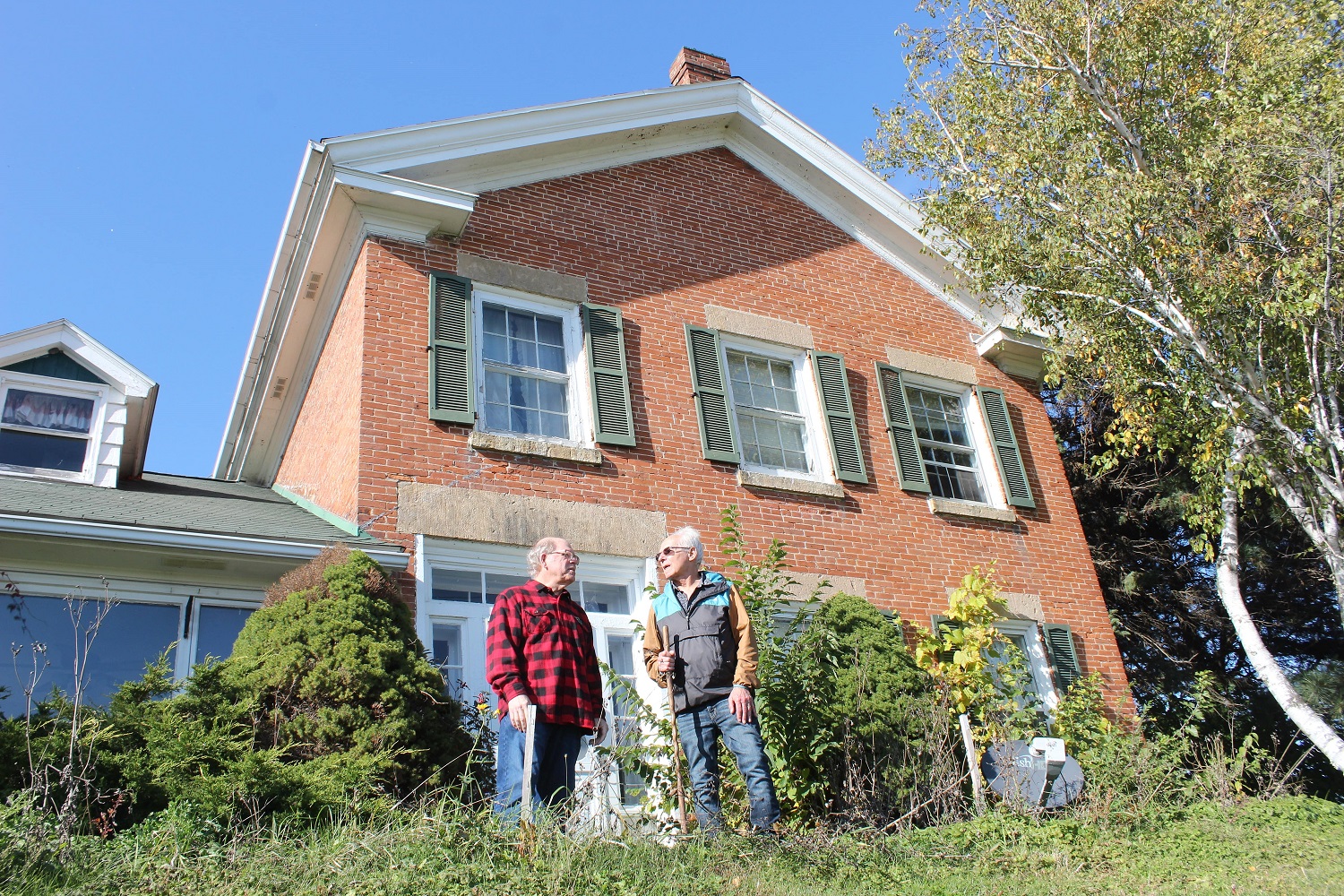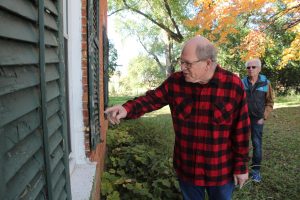Little House in Sun Prairie

LITTLE HOUSE IN SUN PRAIRE
Tensions rise as fast growth threatens a suburb's history
As cars zoom past, a brick house sits empty on South Thompson Road in Sun Prairie, Wisconsin. A planter box painted with two red hearts adorns one of the window sills, perhaps symbolizing a space once well-loved by the families who lived there. Now, the home serves merely as a reflection of the soon-to-be-forgotten heart of this community.
Though a barricade blocks the gravel driveway, the house’s white door seems inviting, asking visitors to come inside to hear the stories within these walls.
For the past 153 years, the Thompson-Schneider home’s brick façade has stayed nearly the same as when it was built and has watched Sun Prairie, once a small agricultural town, transform into a thriving suburb of Madison. Throughout the years, nearly everything around it has changed and evolved into the present century.
Since its incorporation as a village in 1958, Sun Prairie has surged from a population of less than 4,000, to a city of nearly 35,000 in 2019. And the Wisconsin Department of Administration projects the community will continue expanding over the next 10 years — in 2030, its population is expected to reach 41,000 residents. Considering this estimated increase, Sun Prairie city administrator Aaron Oppenheimer says the decline of the community’s historic landmarks, such as the Thompson-Schneider home, should come as no surprise.
Some of the home’s exterior has now faded with age, and it has begun to look out of place among the new retail stores that have sprung up just a mile away. Today, the Civil War-era house stands only as a passing blur in the windows of passengers traveling through Wisconsin, and some might not notice it’s there at all.
Soon, though, the house that represents the city’s rich history will be paved over — and all that remains will be its rubble. Or, perhaps, a parking lot.
In a decision made by the Sun Prairie City Council, the property is fated to turn over to the hands of a developer, who’ll likely build a new grocery store where the farmhouse currently stands. If a deal fails to fall into place, the Sun Prairie Fire Department will burn the home and its eight surrounding structures to the ground as part of its training exercises.
These choices haven’t come easy to the council and its community, however. For years, the farmhouse and other historic buildings in the city have faced the question of whether Sun Prairie should remain set in stone or instead blaze a new path to the future.
While many younger residents push for the modernization of Sun Prairie, longtime residents grapple with the fact that the city is no longer what it once was. This contrast — between the city’s desire for progress and the longing to preserve its past — represents the continually changing values of Sun Prairie and the looming decisions the community will face.
Hearth and home

The Thompson-Schneider house has eight structures on the farm, including two barns, three sheds, a silo and a granary.
As Sun Prairie residents Joe Chase and Peter Klein look longingly at the land, they point out the farmstead’s many quirks — the locally-made brick, the bow-roofed machine shed, the pre-1900 dairy barn, an anti-Vietnam War peace sign located prominently in the backyard.
Chase, former mayor and fifth-generation resident of Sun Prairie, has been a vocal advocate for the preservation of the Thompson-Schneider home. He says the council is changing the community’s image by prioritizing new development over the maintenance of its historic buildings.
“There was always a lot of miscommunication because the city really didn’t want to be involved here,” he says. “They knew they had a number of options — the simplest one in their head was to tear it down.”
But getting rid of the symbols of Sun Prairie’s past, Chase says, may make the community forget how far they’ve come since the 1800s. As the chair of the city’s Historical Library and Museum Board, he has long pushed for historical preservation. Reminders of the past, he says, make people appreciate the choices and efforts of those who once shaped Sun Prairie.
The original owners of the Thompson farmhouse are some of those early settlers whom Chase looks back upon as formative to the city that it is today.
In 1846, then-23-year-old Sereno Thompson ventured on foot from Bristol, Vermont, to Wisconsin in a month-long journey, where he arrived at what would become the sparsely settled township of Burke and eventually the booming city of Sun Prairie.
Thompson and his wife, Sarah, bought a parcel of land there for $250, where they built a modest one-and-a-half story frame house seven years later. In 1866, they then built a Greek Revival brick addition onto the farmhouse — a style of architecture reminiscent of ancient Greek temples. While once popular in the 18th century, Greek Revival buildings are now rare in Dane County. On the Wisconsin Architecture and History Inventory, there is just one other Greek Revival home in Sun Prairie listed; in Madison, only 39 are listed.
According to a 1994 assessment conducted by architectural historian Elizabeth Miller, this was the earliest style of architecture built in Wisconsin. In fact, the use of brick, fieldstone and quarried rock in the construction of early buildings, such as the Thompson house, is a variation particular to the state.
No place like home
In 2018, the city purchased the 41 acres of land, on which the home is located, as the building site for a stormwater drainage pond. The home is being threatened by the population boom of Sun Prairie — one of the fastest-growing cities in the state, trailing only behind Madison last year as the municipality with the largest population increase.
This isn’t the first time the Thompson-Schneider home has faced challenges because of the city’s growth, however.
The same assessment concluded by Miller was prompted by the Department of Transportation’s 1994 expansion of Highway 151, which now connects Sun Prairie to Madison and stretches all the way through Wisconsin and Iowa. At the time, the house was owned by dairy farmer Arthur Schneider, who agreed in 1956 to have his home moved from its original location to make way for the construction of what was then the new four-lane Highway 151.
The move involved careful decision-making by his family. They weighed a number of possible choices — one of which included purchasing farmland elsewhere — before deciding to move and dismantle some of the house. “I lived there 40 years and it is the only home I have ever known,” Schneider told the Wisconsin State Journal.
With the guidance of a UW-Madison farm building specialist, the Schneiders planned to transport the brick section by digging a trench slightly wider than the house. Over a week-long period, the farmhouse was dragged on rollers a few feet a day, bringing the property to its current location just 150 feet from the original site.
After evaluating the home and its history, Miller decided the property met the criteria for the National Register of Historic Places, which is the official list of spaces deemed worthy of preservation. The State Historic Preservation Office also later agreed with Miller’s recommendation for eligibility. To qualify for the list, buildings must meet one of four criteria and have significance in American history. Noting that the original brick face has remained the same since 1866, Miller wrote that the Thompson-Schneider home “embodies the distinctive characteristics” of a style that is architecturally significant at the local level.
Bridges burned
Its unique style is just one of the reasons Klein, who served as the city’s historical museum curator for more than 30 years, says the property should be saved. But the home isn’t the only historic structure that’s faced demolition in Sun Prairie. The city’s past decisions to destroy old buildings, as well as their lack of historical maintenance efforts, show they’re “extremely anti-preservation,” Klein says.

Joe Chase (left) and Peter Klein (right) have urged Sun Prairie City Council members to save the historic Thompson-Schneider home.
Chase, too, thinks the City Council is ignorant of the importance of historic properties. In fact, he says the alders fail to prioritize the history and legacy of the city. “Without that leadership,” Chase continues, “we [have] a City Council of eight people that don’t have roots in Sun Prairie and are very progressive in nature to the point [where] they want to see rapid growth — because it’s an opportunity.”
According to Chase, seizing on change may not always be a positive decision. He suggests that the council’s choices pose challenges in respecting and preserving the past. “You always look at an opportunity and move forward with it,” he says. “You don’t wait for it to crash.”
Both Klein and Chase recall a similar situation as the Thompson-Schneider property, where they were part of an effort in 2000 that kept the city’s one-of-a-kind 1899 water tower standing. The structure is now on the State and National Register of Historic Places after community members petitioned against the council’s decision to demolish it.
Following a natural gas explosion that destroyed a portion of Sun Prairie’s historic downtown district, Klein also says little has been done to restore the crumbling buildings affected, including the original City Hall, built in 1895. “I hope I’m wrong,” he says, “but from everything I’ve learned, the longer you wait with [renovation], the more damage is being done.”
If the city refuses to take action, Klein predicts that frustration from Sun Prairie residents will continue to fester.
“There [are] some beautiful historic homes in this area,” he says. “The people that live here have taken care of them, but they don’t feel like the city’s listening to them.”
A house divided
Despite criticism from the community, the City Council has stuck to its decision to either burn or build over the historic property.
That’s because only 11 of the 41 acres have been used by the city for stormwater drainage, Oppenheimer explains, leaving them with more land than they need. While he sympathizes with those who want to save the home, Oppenheimer advises it’s not a practical solution for the community. “Ultimately, the City Council would make a decision,” he says, “and they’ve decided that [keeping it] is not in the public interest.”
He adds: “The city does not see a public use for the facility. The intent was at the time — and still is — to sell off the property that we do not need for a public purpose.”
Though the sale isn’t official yet, the farm’s “public purpose” will likely be put into the hands of a Michigan-based retail brokerage company that has paid to put a hold on the property until April. One of its largest clients is the Meijer grocery company, which Chase and Klein predict will eventually take the place of the Thompson-Schneider home. Aldi, Target, Woodman’s Market and a Costco wholesale store are all already located within two miles of the site.
Some council members also view the vacant home as a liability, according to city alderman Steve Stocker. “Personally, I’ve not seen anybody trespassing on there,” he says. “But [some council members] just have a burr under their saddle, and they want to get it out of there.”
The council has even offered to give away the home for free to anyone who wants it, as long as the person would be willing to cover the costs to move it — an expense that could run upward of hundreds of thousands of dollars. “If you have the land and you have the means to move it,” Stocker says, “it can be yours.”
If the council fails to come to an agreement with the developer or find a potential owner for the property, they’ll then move forward in leaving it to the fire department. So far, the city has received no proposals from the community to move the home, but Oppenheimer says they’ll keep the option available for as long as possible.
While Stocker still anticipates the home will not end up being saved, Chase, Klein and other community members continue to fight for its survival. They’ve suggested a number of ways to keep the property in its original state: a coffee shop, an office, an art gallery, a cycling store — anything but another place to buy groceries.
“[The City Council] … should analyze their options and listen to the community,” Chase says. “One of the things about preserving historic properties is that once they’re torn down — they’re gone.”
Regardless of the community’s suggestions, the fate of the home still remains up to the council — something that Chase says will be telling of the direction Sun Prairie is heading in the future.
For Oppenheimer, however, sometimes looking to the future means deciding to let go of the past.
“I don’t know that there is an option just to leave the house as is,” he says. “I know that there’s interest in the community in doing that, but they have to present an option that is viable.”

Kayla Huynh | Editor in Chief
Senior studying both journalism and strategic communication with a certificate in Asian American studies
